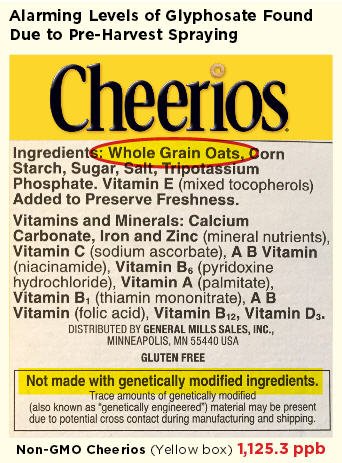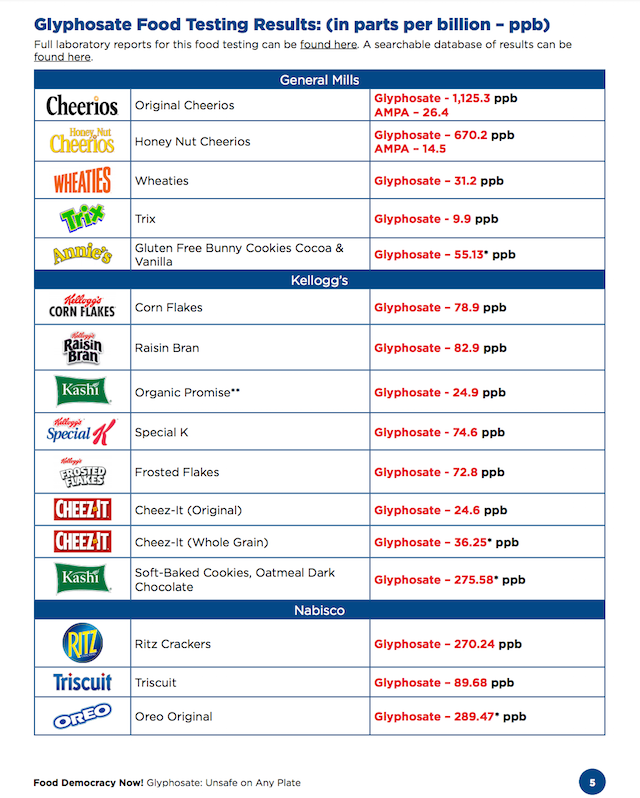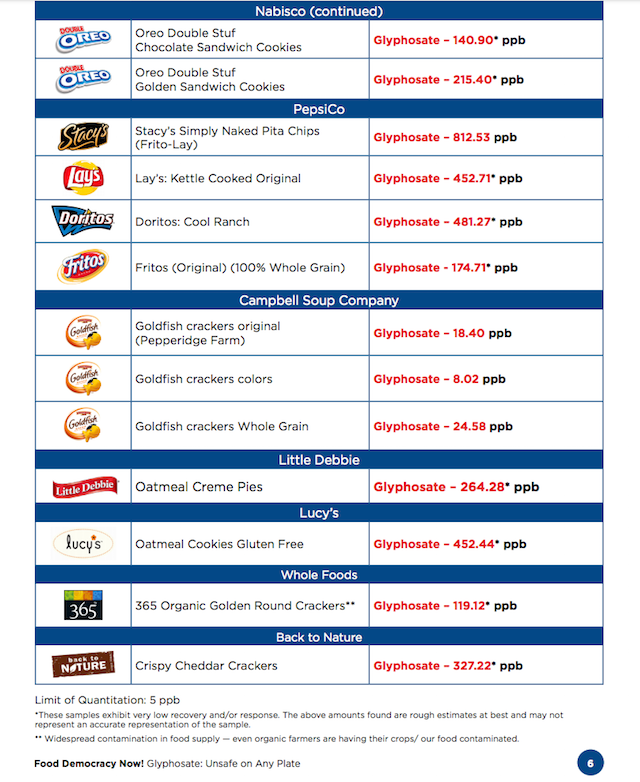Glyphosate On Your Plate: America’s Food Crisis
Barbara H. Peterson
Don't want to eat glyphosate, the world's most popular herbicide manufactured by Monsanto and commonly known as Roundup? Too bad. Eat it anyway.
Foods that are promoted as healthy and nutritious, even organic and non-GMO have been shown to contain an extra little ingredient added by the chemical/agricultural giant known as Monsanto, to give your breakfast, lunch, dinner and snacks that added boost of "nutrition." Yes, folks, stand up and applaud the American food regulatory agencies for allowing what's on your plate to be contaminated on an unprecedented scale with the herbicide known as glyphosate.
HISTORY OF GLYPHOSATEThere are 3 patents on glyphosate: It was first patented in 1964 by Stauffer Chemical as a metal chelator that was used to clean or descale commercial boilers and pipes (2). Glyphosate binds to and removes minerals such as calcium, magnesium, manganese, copper and zinc that are vital to our health.
The second patent was filed in 1974 by Monsanto as an herbicide (3). Monsanto claims that glyphosate, which kills plants by disrupting the shikimate pathway, has no effect on humans because the shikimate pathway is not present in mammals. However a recent peer-reviewed study (4) states, “Glyphosate inhibits the cytochrome P450 (CYP) enzyme which is an overlooked component of its toxicity to mammals. CYP enzymes play crucial roles in biological function, one of which is to detoxify xenobiotics (foreign chemical substances). Thus, glyphosate enhances the damaging effects of other food borne chemical residues and environmental toxins. Negative impact on the body is insidious and manifests slowly over time as inflammation damages cellular systems throughout the body.”
In 2003, Monsanto filed for a patent on glyphosate as a parasitic control type antimicrobial, or antibiotic (5). This patent was granted in 2010. It is proposed that glyphosate be used as a treatment for microbial infections and parasitic control of various diseases such as malaria. A 2013 peer reviewed study documented that glyphosate kills certain beneficial gut flora in chickens at a level as low as .075 ppm (6).
Yum! Just what I want for breakfast.Read the following alarming report by Food Democracy Now and the Detox Project to get a real eye-opener about the food you are most likely eating and feeding to your children. (html comment removed: more)
Glyphosate: Unsafe on Any Plate
Executive Summary
A leading FDA-registered food safety testing laboratory has found extremely high levels of the pesticide glyphosate in some of America’s most popular food products.
Glyphosate, the active ingredient in Monsanto’s Roundup, is the most heavily used chemical weedkiller in food and agricultural production in human history, as a result of the widespread adoption of genetically engineered crops now grown on more than 175 million acres in the United States (U.S.) and more than 440 million acres around the globe.
New scientific evidence shows that probable harm to human health could begin at ultra-low levels of glyphosate e.g. 0.1 parts per billions (ppb). Popular foods tested for glyphosate measured between 289.47 ppb and at levels as high as 1,125.3 ppb.
The testing and analysis was performed by Anresco Laboratories, San Francisco, an FDA registered laboratory that has performed expert food safety testing since 1943. The laboratory found that well-known products tested for glyphosate, Original Cheerios, for example, measured levels as high as 1,125.3 ppb. Other high levels of glyphosate were found in familiar products such as Oreos, Doritos, and Ritz Crackers, among 29 foods tested.
Currently, U.S. regulators allow a very high level of daily glyphosate residue in America’s food. The acceptable daily intake (ADI) limit is set at 1.75 milligrams per kilogram of bodyweight per day (written 1.75 mg/kg bw/day) in the U.S., versus a more cautious 0.3 mg/kg bw/day in the European Union. Tolerances have been set through the submission of corporate-sponsored studies and industry influence on the regulatory process.
New research shows that Roundup causes liver and kidney damage in rats as reflected in changes in the functions of 4,000 genes at only 0.05 parts per billion (ppb) glyphosate equivalent indicating damage.
Additional studies have found that levels as low as 10 ppb can have toxic effects on the livers of fish and cause significant damage to the livers and kidneys of rats at 700 ppb, which is the allowable level of glyphosate found in U.S. drinking water.
Credible independent, peer-reviewed scientific evidence now shows that the levels of harm to human health could begin at the ultra-low levels of 0.1 parts per billion (ppb) of glyphosate.
These groundbreaking new findings that one of the most iconic cereals in U.S. contains levels as high as 1,125.3 ppb should be a wake-up call for all Americans regarding unacceptable levels of pesticide residues in our nation’s food. These findings are especially troubling, considering that the latest independent scientific evidence, during which a team of international scientists re-evaluated the same data previously used by regulators, calls for a much lower ADI to be set at 0.025 mg/ kg of bodyweight per day or “12 times lower than the ADI” currently set in Europe and 70 times lower than the level currently allowed by the EPA in the United States.
It’s important for individuals and parents to understand that glyphosate contamination cannot be removed by washing and is not broken down by cooking or baking. Glyphosate residues can remain stable in food for a year or more, even if the foods are frozen or processed.
The testing and analysis was performed at the request of FOOD DEMOCRACY NOW!, in coordination with THE DETOX PROJECT, which gathered additional scientific evidence from around the world and included a compendium of independent research on glyphosate that contains Anresco Laboratory’s findings.
Based on this new information, FOOD DEMOCRACY NOW! is calling for a federal investigation into the likely harmful effects of glyphosate on human health and the environment and is also seeking an investigation into the relationships between the regulators and the regulated industries, which has resulted in the public being exposed to levels of glyphosate which scientific studies show can be damaging to human health.
DOWNLOAD FULL REPORT HERE
©2016 Barbara H. Peterson


